1932 AN EROTIC YEAR
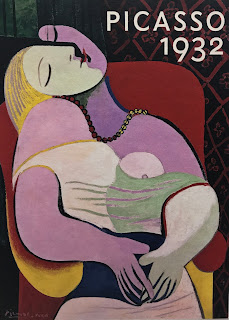 Laurent had sent over to me a series of pictures of installations at the Karsten Greve gallery. Despite my lack of interest in such work, these looked fascinating. I’ll give it a try. It was a cold bleak day when I started off. As I do everything I can on foot in Paris, I try out new ways of going somewhere with the GPS on my ‘phone. Such new paths can be fascinating or frankly silly - like going down all the parallel streets to get to your destination making the walk at times very much longer. This was the case so by the time the turn to the gallery came into sight, I changed course and went by the Picasso museum. A new exhibition opened in October which was written in black lettering on my list. « 1932 - and Erotic year .» With such a title I was sure the crowds would be queuing up for some way…no-one.
Laurent had sent over to me a series of pictures of installations at the Karsten Greve gallery. Despite my lack of interest in such work, these looked fascinating. I’ll give it a try. It was a cold bleak day when I started off. As I do everything I can on foot in Paris, I try out new ways of going somewhere with the GPS on my ‘phone. Such new paths can be fascinating or frankly silly - like going down all the parallel streets to get to your destination making the walk at times very much longer. This was the case so by the time the turn to the gallery came into sight, I changed course and went by the Picasso museum. A new exhibition opened in October which was written in black lettering on my list. « 1932 - and Erotic year .» With such a title I was sure the crowds would be queuing up for some way…no-one. So change of course and into the Picasso. May have been no-one outside but this was not the case inside.

The exhibition was set out month by month. 366 days in the life of Picasso. At the end of the exhibition, I did buy the catalogue. There was a time-line which was filled with so much information - exhibitions around Europe, the number of paintings he had done in a day or a month, relationships with family and friends. Extremely interesting. Why though was 1932 so important? This was the year of Marie-Therese. Here is a photo of the people who were key players in Picasso's life that year
By 1932, Picasso was rich, known all over the world and solicited by major museums for exhibitions, book illustrations, autographs after interviews, book to illustrate and money…
Even if the exegetes knew about this new muse, Marie-Therese’s identity was not revealed before a publication in 1958.
The story goes that he crossed her in one of our major department stores and was seduced by her physical appearance. Telling her who he was (the question is, did she know the name?) and that he wanted to do a portrait of her.
 | |||||||||
Even today, how often and where did he see her? Olga and Paul were in their house at Boisgeloup which means that she couldn’t go there.
La Rue de la Boétie perhaps? Apparently she did what she wanted to. Changing meetings and doing everything I would think for a young woman who was not yet of age and who could have caused considerable harm to Picasso’s reputation if the affair had come to light. (That’s me who is saying this!) Whichever way we look at it, all the paintings that Picasso did in 1932 included Marie-Therese. One interesting aspect of this is that on the 2nd of January, there was only a quarter moon showing one side in the shade and the other in light. As you will see, many paintings of the young lady have her face cut into two with her blond hair. Below are the first two which were done on Saturday the 2nd of January.
 |
As the months go by, the paintings become more and more erotic but Marie-Therese is very much « there ». I have often asked myself - "what is there about Picasso that draws women to him?" . When I look at a photo like this and then compare it with others, those eyes are black piercing and my Mother would have said, "come-on eyes"
As we go along, I will add some comments, but most of the paintings are self explanatory - remembering of course, who they are!
 |
| Figures at the seaside |
This was the first of the year and painted on the 2nd of January 1932. At first it was an experimental sculpture then introduced into many paintings as the year went by. The mop of hair: the turned up nose (phallic) ...
 |
| Nude before a mirror |
 |
| "La Lecture" |
Also done on the 2nd January and from the former description we know at once it is Marie-Therese. Many of these early paintings of her show how preoccupied he is.
 |
| The Yellow belt - 7th January |
 |
| Woman sitting in a red arcmchair |
 |
| Woman sitting in a red arcmchair |
 |
| Study for a woman playing the mandoline |
 |
| Naked woman lying down |
 |
| Head of a Woman |
 |
| The Painter and his model before a red armchair |
 |
| The Dream - This suggest because of the red armchair, that it could have been painted in the Paris flat at rue de la Boétie. |
 |
| Resting |
Once again, this could have been painted in Paris. Marie-Therese certainly met Picasso in his atelier there. Once she was aked by one of Picasso's friends and her reply was "He took me to his studio, he looked at me, looked at my face, then I stayed and then I left"!
 |
| Girl with a mandoline - 10th January |
 |
| Sleeping in front of a miror - 14th January |
 |
| Woman lying down |
 |
| Fruit bowl and guitare - suddenly there can be a break |
 |
| Nude in a black armchair |
 |
| Sculpture of a head (Marie-Therese) |
 |
| Sleeping on a red cushion (Marie-Therese) |
 |
| Swimmer |
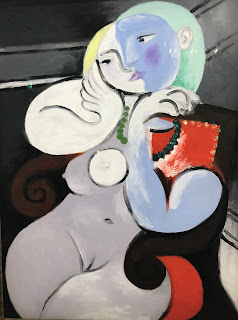 |
| Nude woman in a red chair (La Boétie?) |
 |
| The siesta |
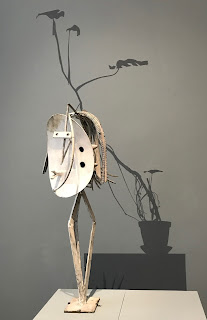 |
| Head of a woman |
I love this. It's done in iron, metal sheet and painted strainers! The shadow on the wall is quite beautiful.
 |
| Three swimmers |
 |
| The three graces but who? |
 |
| The Diver |
 | ||
| The Rescue |
 |
| Nude lying down with her golden hair |
 |
| Girls playing with a ball on the beach |
Although there are no papers in Picasso's archives, we do know that Marie-Therese sent him letters and photographs over the summer months which surely gave way to a fantaisie world and were the roots of his summer paintings.
 |
| The Rescue |
 |
| Marie-Therese thinking |
 |
| Woman sitting next to a window |
 |
| Girl lying down next to a flute player |
 |
| Flute player and nude lying down |
 |
| Flute player and nude lying down |
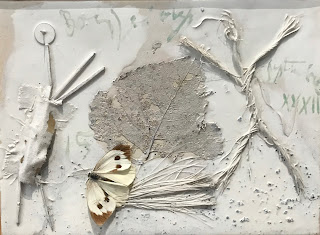 |
| Composition with a buterfly. |
This too was quite beautiful and unusual from my point of view for Picasso. Made out of Cloth, wood, string oil on the cloth and the butterfly.
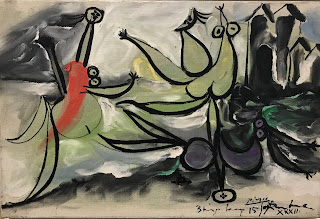 |
| The three bathers |
 |
| Three girls playing on the beach |
 |
| The Cucifixion following Grünewald |
 |
| Playing with a ball on the beach |
 |
| Playing with a ball on the beach |
 |
| Flute player and nude lying down |
 |
| Two woman on the beach in front of their beach cabin. |
Surprisingly enough there were a lot of children with their parents. The teenagers seemed to be bored stiff and found their smart ‘phones much more appealing than breasts or other. Younger children, let’s say from 5 to 9 or 10, were fascinated by their parent’s explanations and went from painting to painting pointing out the « erotica » they had found. We were many to listen to some of the different explanations.
This is the first time perhaps that I have looked closely at one of Picasso's many women. I am sure that their are books dedicated to each one of his wives and mistresses. It was only through Nicky's "copy" of a very famous Dora Maar painting that I saw that there was a real trend in his paintings of one of his treasured lovers.
Not the most succesful photo I know. But you may understand what I mean. I hope so.
It didn't end there.
Before 1947, only two paintings and one drawing by Picasso were registerd in the collectiuon inventory. At the request of Jean Cassou and Georges Salles, the new Director of the French Museums, the painter generously offered to donate ten major works produced in between 1926 and 1945 to the Modern Art Museum. These were representative of Picasso most recent years of production and featuring his favorite themes...here are just some of them.
 |
| Figure around 1927 |
 |
| Still life with lemons and oranges -7th December, 1936 |
 |
| Still life with Cherries : 9th June - 6th August, 1943 |
 |
| The enameled pan - 16th February, 1945 |
 |
| Woman's bust - 1926 |
 |
| Portrait of a Woman (Dora Maar?) 1938 |
 |
| The Rocking Chair - Boisgeloup, 9th August,1943 |
 |
| Portrait of Dora Maar - 1937 |
 |
| Aubade - 1942 |
 |
| Study for the Aubade : 1941 |
 |
| Study for the Aubade - 20th March 1941 |




Commentaires